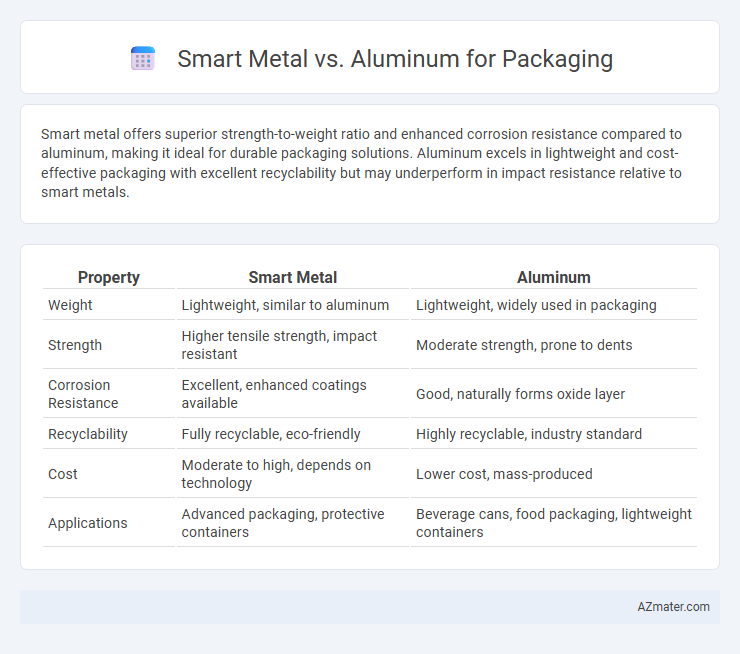Smart metal offers superior strength-to-weight ratio and enhanced corrosion resistance compared to aluminum, making it ideal for durable packaging solutions. Aluminum excels in lightweight and cost-effective packaging with excellent recyclability but may underperform in impact resistance relative to smart metals.
Table of Comparison
| Property | Smart Metal | Aluminum |
|---|---|---|
| Weight | Lightweight, similar to aluminum | Lightweight, widely used in packaging |
| Strength | Higher tensile strength, impact resistant | Moderate strength, prone to dents |
| Corrosion Resistance | Excellent, enhanced coatings available | Good, naturally forms oxide layer |
| Recyclability | Fully recyclable, eco-friendly | Highly recyclable, industry standard |
| Cost | Moderate to high, depends on technology | Lower cost, mass-produced |
| Applications | Advanced packaging, protective containers | Beverage cans, food packaging, lightweight containers |
Introduction to Smart Metal and Aluminum Packaging
Smart metal packaging leverages advanced materials incorporating sensor technology to enhance product protection, freshness monitoring, and anti-counterfeiting features, revolutionizing traditional packaging methods. Aluminum packaging offers lightweight, corrosion-resistant, and highly recyclable solutions widely used in food and beverage industries due to its barrier properties and sustainability. Both materials prioritize innovation and environmental considerations but differ in functionality and application scope within the packaging sector.
Material Properties: Smart Metal vs Aluminum
Smart metal offers enhanced strength-to-weight ratio and superior corrosion resistance compared to conventional aluminum, making it ideal for durable packaging applications. Its advanced alloy composition provides improved flexibility and impact resistance, which reduces damage during transit and handling. Aluminum, while lightweight and highly recyclable, often requires additional surface treatments to achieve similar durability and protection against environmental factors.
Sustainability and Environmental Impact
Smart metal packaging offers enhanced recyclability and durability compared to aluminum, reducing waste and energy consumption during production. Aluminum requires high energy input for extraction and processing, but its lightweight nature contributes to lower transportation emissions. Both materials support circular economy principles, though smart metal innovations often integrate sustainable coatings and reduced material usage to minimize environmental impact.
Cost Comparison and Economic Viability
Smart metal packaging often incurs higher initial costs compared to aluminum due to advanced technologies and materials used for enhanced durability and functionality. Aluminum remains economically viable because of its widespread availability, lower production costs, and recyclability, which reduces lifecycle expenses. Over time, the total cost of ownership for smart metal may balance out through improved product protection and reduced waste, but aluminum maintains a strong cost advantage for mass-market packaging.
Barrier Protection: Preserving Product Freshness
Smart metal packaging offers superior barrier protection compared to aluminum, effectively blocking moisture, oxygen, and light, which are critical factors in preserving product freshness. Aluminum provides excellent resistance to corrosion and acts as a strong barrier but may require additional coatings to enhance its impermeability. Enhanced barrier properties in smart metal packaging extend shelf life and maintain product quality, making it a preferred choice for sensitive food and pharmaceutical products.
Customization and Design Flexibility
Smart metal packaging offers superior customization options with advanced printing technologies and precise shaping capabilities, enabling intricate designs and brand-specific finishes. Aluminum provides excellent design flexibility due to its lightweight nature and malleability, allowing for diverse container shapes and sizes while maintaining durability. Both materials enhance packaging appeal, but smart metal solutions excel in tailored aesthetics and functional innovation.
Recyclability and End-of-Life Solutions
Smart metal packaging offers superior recyclability compared to aluminum due to its high recovery rate and closed-loop recycling systems, which minimize waste and energy use. Aluminum is also recyclable, but its processes require more energy and generate higher emissions during smelting, impacting its end-of-life environmental footprint. Innovations in smart metal technologies enhance material reuse and circularity, making them a preferred solution for sustainable packaging.
Application Areas in Packaging Industry
Smart metal materials, such as coated steel and aluminum alloys, excel in packaging applications requiring high durability and corrosion resistance, making them ideal for food and beverage containers. Aluminum's lightweight nature and excellent barrier properties are widely preferred for beverage cans, pharmaceutical packaging, and cosmetics, ensuring product freshness and extended shelf life. The packaging industry benefits from smart metal's adaptability in manufacturing recyclable, lightweight, and protective packaging solutions, enhancing sustainability and consumer safety.
Consumer Perceptions and Market Trends
Smart metal packaging offers enhanced durability and recyclability, appealing to environmentally conscious consumers seeking sustainable options. Aluminum remains favored for its lightweight, corrosion resistance, and cost-effectiveness, driving strong demand in beverage and food sectors. Market trends indicate growing preference for smart metals due to their innovative coatings and surface treatments that improve shelf life and consumer experience.
Future Innovations in Packaging Materials
Smart metal packaging integrates advanced sensors and conductive materials to enhance product freshness monitoring and tamper detection, offering a future-forward alternative to traditional aluminum. Aluminum remains valued for its lightweight, recyclability, and barrier properties, but innovations like nanocoatings and hybrid composites are pushing smart metal systems ahead in sustainability and functionality. Emerging trends focus on combining smart metals with biodegradable layers and IoT-enabled features to revolutionize packaging efficiency and consumer interaction.

Infographic: Smart metal vs Aluminum for Packaging
 azmater.com
azmater.com